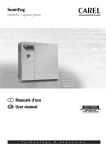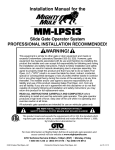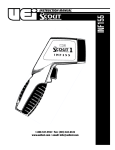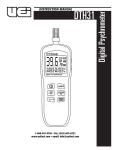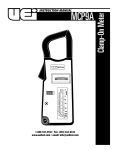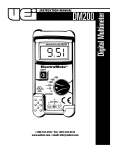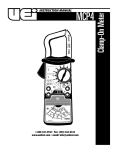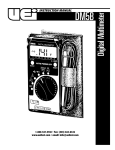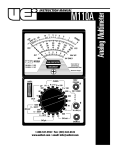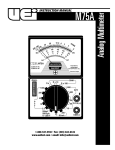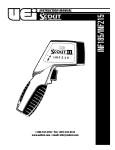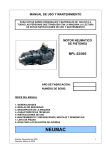Download UTL260 - SupplyHouse.com
Transcript
INSTRUCTION MANUAL UTL260 1-800-547-5740 • Fax: (503) 643-6322 www.ueitest.com • email: [email protected] Introduction The UTL260 has all the features and measurement functions that appliance technicians need. It’s ruggedized and slim compact design makes for easy one handed use. Features include • AC current 2A/20A/200A • AC/DC voltage 600V • Resistance 2kΩ • Audible continuity • LCD display with MAX reading 1999 • Automatic indication of functions and symbols • Sample rate: 2 times/sec for digital data • Backlit display for use in low light application • Read the safety precautions associated with the equipment being tested and seek assistance or advice when performing unfamiliar tasks. • Keep your fingers away from the test lead metal probe contacts and bus-bars when making measurements. Always grip the instrument and test-leads behind the hand guards (molded into the probes). • In the event of electrical shock, ALWAYS bring the victim to the emergency room for evaluation, regardless of the victim’s apparent recovery. Electrical shock can cause an unstable heart rhythm that may need medical attention. International Symbols Safety Notes Before using this meter, read all safety information carefully. In this manual the word "WARNING" is used to indicate conditions or actions that may pose physical hazards to the user. The word "CAUTION" is used to indicate conditions or actions that may damage this instrument. WARNING! Exceeding the specified limits of this meter is dangerous and can expose the user to serious or possibly fatal injury. • DO NOT attempt to measure any voltage that exceeds 600 volts with this meter - UEi offers numerous alternatives for measuring high voltage and current • Voltages above 60 volts DC or 30 volts AC may constitute a serious shock hazard • DO NOT attempt to use this meter if either the meter or the test leads have been damaged. Send unit in for repair by a qualified repair facility • Test leads must be fully inserted prior to taking measurements • Always turn off power to a circuit (or assembly) under test before cutting, unsoldering or breaking the current path. Even small amounts of current can be dangerous • Always disconnect the live test lead before disconnecting the common test lead from a circuit • When measuring high voltage, disconnect the power source before making test lead connections. Connect the test leads to the meter first then to the circuit under test. Reapply power • If any of the following indications occur during testing, turn off the power source to the circuit under test: • Arcing • Flame • Smoke • Extreme Heat • Smell of Burning Materials • Discoloration or Melting of Components Controls and Indicators 1. Transformer jaws 2. Protection ring 3. Jaw opening trigger 4. Light key 5. LCD display 6. COM terminal 7. VΩ terminal 1 8. Power key 9. R o t a ryswitch 10. Hold key 2 10 3 9 4 5 6 UTL260-MAN 8 7 P. 1 LCD Display Functional Description 1. Low battery indication 2. Hold data indication 3. C o n t i n u i tyfunction indication 4. Ohm measurement indication 5. Voltage measurement indication 6. Current measurement indication 7. DC input indication 8. AC input indication 9. Po l a r i tyindication 1 2 3 (Fig 1) DC Voltage Measurement 7 4 8 5 9 6 WARNING! Maximum input voltage of DC V range is 600V DC. Do not attempt to take any voltage measurement that exceeds 600V DC to avoid electrical shock and/or damage to the instrument. 1. Set the rotary switch to the 600V “ “ range. Operating Instructions 2. Connect the black and red test leads to the “COM” and “VΩ” terminals respectively. If the current under measurement is higher than the selected value for a long period, overheating may take place, compromising the safety and operation of inner circuits. 3. Connect the test leads to the circuit being measured and read the displayed value (Fig 2). WARNING! DO NOT measure currents on high-voltage conductors (>600V) to avoid risk of discharge and/or incorrect readings. AC Current Measurement WARNING! Make certain that all test leads are disconnected from the meter terminals. 1. Set the rotary switch to the desired A~range. 2. Clamp the current transducer (jaw) around one of the conductors under test. Make sure that the clamp jaw is closed (Fig 1). 3. Read the display value. 4. When only the figure “1” is displayed, it indicates over-range situation and the higher range has to be selected. (Fig 2) UTL260-MAN P. 2 AC Voltage Measurement WARNING! Maximum input voltage of AC V range is 600Vrms. Do not attempt to take any voltage measurement that exceeds 600Vrms to avoid electrical shock hazard and/or damage to the instrument. 1. Set the rotary switch to the 600V~range. 2. Connect the black and red test leads to the “COM” and “VΩ” terminals respectively. 3. Connect the test leads to the circuit being measured and read the displayed value (Fig 3). (Fig 4) Continuity Measurement WARNING! Before taking any in-circuit resistance measurements, remove power from the circuit being tested and discharge all capacitors. 1. Set the rotary switch to “ Ω“ range. 2. Connect the black and red test leads to the “COM” and “VΩ” terminals respectively. 3. Connect the test leads to the resistance in the circuit being measured (Fig 5). 4. When the test lead to the circuit is below 50Ω, it will be indicated by a continuous beeping. NOTE: Continuity test is available to check open/short of the circuit. (Fig 3) Resistance Measurement WARNING! Before taking any in-circuit resistance measurements, remove power from the circuit being tested and discharge all capacitors. 1. Set the rotary switch to the 600V~range. 2. Connect the black and red test leads to the “COM” and “VΩ” terminals respectively. 3. Connect the test leads to the circuit being measured and read the displayed value (Fig 4). Short Circuit Beeper Open Circuit UTL260-MAN (Fig 4) P. 3 Maintenance Periodic service WARNING! Repair and service of this instrument is to be performed by qualified personnel only. Improper repair or service could result in physical degradation of the meter. This could alter the protection from electrical shock and personal injury this meter provides to the operator. Perform only those maintenance tasks that you are qualified to do. These guidelines will help you attain long and reliable service from your meter: WARNING! Under NO circumstance should you expose batteries to extreme heat or fire as they may explode and cause injury. 3. Place a fresh 9V battery in the compartment. NOTE: If you do not plan to use the meter for a month or more, remove the battery and store it in an area that won’t be damaged by a leaking battery. 4. Reattach the battery compartment cover to the meter and reinstall the screw. Specifications 1. Calibrate your meter annually to ensure it meets original performance specifications. 2. Keep your meter dry. If it gets wet, wipe it dry immediately. Liquids damage electronic circuits. 3. Whenever pra c t i cal, keep the meter away from dust and dirt, which can cause premature wear. 4. Although your meter is built to withstand the rigors of daily use, it can be damaged by severe impacts. Use reasonable caution when using and storing the meter. Cleaning and Decontamination Periodically clean your meter’s case using a damp cloth. DO NOT use abrasives, cleaning solvents or strong detergents, as they may damage the finish or affect the reliability of the structural components. Environment conditions Pollution degree Altitude Operating temperature Storage temperature Max. Voltage between terminals and earth ground Operating principal Sample rate Display Range selection Over range indication Low battery indication Battery Replacement Always use a fresh replacement battery of the specified size and type. Immediately remove the old or weak battery from the meter and dispose of it in accordance with your local disposal regulations. Old or defective batteries can leak chemicals that corrode electronic circuits. WARNING! To avoid electric shock, be sure to turn off the meter’s power and disconnect both test leads from any equipment before you remove or install batteries. Power source Polarity indication Jaw opening diameter Maximum conductor size Dimensions Weight Accessories Installation categories II, 600V max. to earth 2 < 2000 m 0˚~40˚C (<80% RH) -10˚~60˚C (<70% RH, battery removed) 600 V rms Dual slop integration 2 times/sec for digital data 3-1/2 digits LCD display with max. Reading 1999 Automatic indication of functions and symbols Manual LCD will display “1”. If measure value is over 2000V the LCD will display “1” (AC V & DC V range) The “ “ is displayed when the battery is under the proper operation range DC 3VX3, CR2032 “-” displayed automatically cables 28mm 28mm 194 (L) x 72 (W) x 35 (H) mm 200g. Approx. (battery included) Manual Test leads Carrying case To install a new battery, follow these procedures: 1. Remove the screw from the battery compartment cover on the back of the meter and lift the cover. 2. Remove and discard the old battery. Always dispose of old batteries promptly in a manner consistent with local disposal regulations. UTL260-MAN P. 4 Measurement Specifications *Alignment marks Audible Continuity MARK Range CONDUCTOR MARK Continuity beeper < approximately 50Ω Open circuit voltage: less than 700mV Overload protection: 250V DC or 250V AC rms MARK Position the conductor within the jaws at the intersection of the indicated marks as much as possible in order to meet this meter’s accuracy specifications. If the conductor is positioned elsewhere within the jaws, the max. additional error resulted is 1.5%. *Accuracy: ±(% of reading + number of digits) at 64˚ to 82˚F (18˚ to 28˚C) with relative humidity to 80%. AC Current Range 2A 20A 200A Resolution 0.001A 0.01A 0.1A Accuracy ±(2%+5) Frequency response: 50/60Hz DC Voltage Range 600V Resolution 1V Accuracy ±(1%+5) Input impedance: 10MΩ Maximum input voltage: 600V DC or 600V AC rms AC Voltage Range 600V Resolution 1V Accuracy ±(1.5%+5) Input impedance: 10MΩ Frequency response: 40~400Hz Maximum input voltage: 600V DC or 600V AC rms Resistance Range 2kΩ Resolution 1Ω Accuracy ±(1%+5) Open circuit voltage: less than 700mV Overload protection: 250V DC or 250V AC rms UTL260-MAN P. 5 UTL260 Digital Clamp-On Meter Limited Warranty The UTL260 is warranted to be free from defects in materials and workmanship for a period of one year from the date of purchase. If within the warra n ty period your instrument should become inoperative from such defects, the unit will be repaired or replaced at UEi’s option. This warra n ty covers normal use and does not cover damage which occurs in shipment or failure which results from alteration, tampering, accident, misuse, abuse, neglect or improper maintenance. Batteries and consequential damage resulting from failed batteries are not covered by warra n ty. Any implied warranties, including but not limited to implied warranties of merchantability and fitness for a particular purpose, are limited to the express warranty. UEi shall not be liable for loss of use of the instrument or other incidental or consequential damages, expenses, or economic loss, or for any claim or claims for such damage, expenses or economic loss. A purchase receipt or other proof of original purchase date will be required before warra n ty repairs will be rendered. Instruments out of warra n ty will be repaired (when repairable) for a service charge. Return the unit postage paid and insured to: 1-800-547-5740 • FAX: (503) 643-6322 www.ueitest.com • Email: [email protected] UTL is distributed by UEi This warranty gives you specific legal rights. You may also have other rights which vary from state to state. PLEASE RECYCLE Copyright © 2007 UEi UTL260-MAN 4/07







